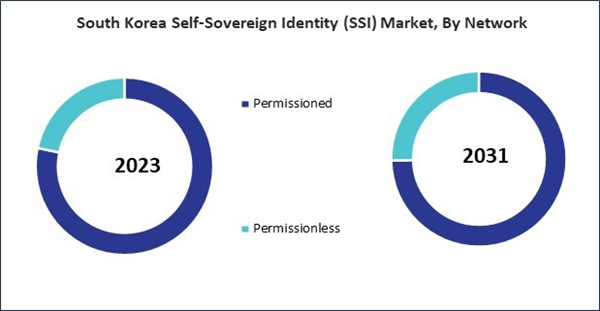The Asia Pacific Self-Sovereign Identity (SSI) Market would witness market growth of 83.3% CAGR during the forecast period (2024-2031).
The China market dominated the Asia Pacific Self-Sovereign Identity (SSI) Market by Country in 2023, and would continue to be a dominant market till 2031; thereby, achieving a market value of $8,665.2 million by 2031. The Japan market is registering a CAGR of 82.1% during (2024 - 2031). Additionally, The India market would showcase a CAGR of 84.5% during (2024 - 2031).
Companies that adopt SSI solutions can differentiate themselves in the market by demonstrating a commitment to user privacy and data security. This can lead to increased customer trust, loyalty, and competitive advantage. As a result, businesses are incentivized to invest in SSI technologies to meet their customers' evolving expectations. Also, developing interoperable standards and protocols for decentralized identity promotes innovation and growth in the market.
Standards such as Decentralized Identifiers (DIDs) and Verifiable Credentials enable seamless exchange and verification of identity data across different systems and platforms. Likewise, advances in blockchain technology, cryptographic techniques, and decentralized architectures drive the development of SSI solutions. Innovations enhance SSI platforms' scalability, privacy, and usability, making them more accessible and practical for various applications.
Industries across the Asia Pacific region, particularly manufacturing, agriculture, and healthcare, are embracing IoT to improve operational efficiency, reduce costs, and enhance productivity. With the proliferation of IoT devices in various sectors, there's an increased need for robust SSI solutions to protect sensitive data and infrastructure from cyber threats. Therefore, increased internet penetration and growing digital transformation in the Asia Pacific lead to market growth.
Based on Offering, the market is segmented into Solution and Services. Based on Network, the market is segmented into Permissioned and Permissionless. Based on Identity Type, the market is segmented into Biometrics and Non-Biometrics. Based on Organization Size, the market is segmented into Large Enterprises and Small & Medium Enterprises. Based on Vertical, the market is segmented into BFSI, Government, Media & Entertainment, Healthcare & Lifesciences, Travel & Hospitality, Real Estate & Construction, Retail & Consumer Goods, Telecom & IT, and Others. Based on countries, the market is segmented into China, Japan, India, South Korea, Australia, Malaysia, and Rest of Asia Pacific.
The China market dominated the Asia Pacific Self-Sovereign Identity (SSI) Market by Country in 2023, and would continue to be a dominant market till 2031; thereby, achieving a market value of $8,665.2 million by 2031. The Japan market is registering a CAGR of 82.1% during (2024 - 2031). Additionally, The India market would showcase a CAGR of 84.5% during (2024 - 2031).
Companies that adopt SSI solutions can differentiate themselves in the market by demonstrating a commitment to user privacy and data security. This can lead to increased customer trust, loyalty, and competitive advantage. As a result, businesses are incentivized to invest in SSI technologies to meet their customers' evolving expectations. Also, developing interoperable standards and protocols for decentralized identity promotes innovation and growth in the market.
Standards such as Decentralized Identifiers (DIDs) and Verifiable Credentials enable seamless exchange and verification of identity data across different systems and platforms. Likewise, advances in blockchain technology, cryptographic techniques, and decentralized architectures drive the development of SSI solutions. Innovations enhance SSI platforms' scalability, privacy, and usability, making them more accessible and practical for various applications.
Industries across the Asia Pacific region, particularly manufacturing, agriculture, and healthcare, are embracing IoT to improve operational efficiency, reduce costs, and enhance productivity. With the proliferation of IoT devices in various sectors, there's an increased need for robust SSI solutions to protect sensitive data and infrastructure from cyber threats. Therefore, increased internet penetration and growing digital transformation in the Asia Pacific lead to market growth.
Based on Offering, the market is segmented into Solution and Services. Based on Network, the market is segmented into Permissioned and Permissionless. Based on Identity Type, the market is segmented into Biometrics and Non-Biometrics. Based on Organization Size, the market is segmented into Large Enterprises and Small & Medium Enterprises. Based on Vertical, the market is segmented into BFSI, Government, Media & Entertainment, Healthcare & Lifesciences, Travel & Hospitality, Real Estate & Construction, Retail & Consumer Goods, Telecom & IT, and Others. Based on countries, the market is segmented into China, Japan, India, South Korea, Australia, Malaysia, and Rest of Asia Pacific.
List of Key Companies Profiled
- Microsoft Corporation
- Ping Identity Holding Corp. (Thoma Bravo, L.P.)
- IDEX Biometrics ASA
- NEC Corporation
- Validated ID, SL
- Wipro Limited
- Persistent Systems Limited
- Trinsic Inc.
- Soulverse Inc.
- Vereign AG
Market Report Segmentation
By Offering- Solution
- Services
- Permissioned
- Permissionless
- Biometrics
- Non-Biometrics
- Large Enterprises
- Small & Medium Enterprises
- BFSI
- Government
- Media & Entertainment
- Healthcare & Lifesciences
- Travel & Hospitality
- Real Estate & Construction
- Retail & Consumer Goods
- Telecom & IT
- Others
- China
- Japan
- India
- South Korea
- Australia
- Malaysia
- Rest of Asia Pacific
Table of Contents
Chapter 1. Market Scope & Methodology
Chapter 2. Market at a Glance
Chapter 3. Market Overview
Chapter 4. Asia Pacific Self-Sovereign Identity (SSI) Market by Offering
Chapter 5. Asia Pacific Self-Sovereign Identity (SSI) Market by Network
Chapter 6. Asia Pacific Self-Sovereign Identity (SSI) Market by Identity Type
Chapter 7. Asia Pacific Self-Sovereign Identity (SSI) Market by Organization Size
Chapter 8. Asia Pacific Self-Sovereign Identity (SSI) Market by Vertical
Chapter 9. Asia Pacific Self-Sovereign Identity (SSI) Market by Country
Chapter 10. Company Profiles
Companies Mentioned
- Microsoft Corporation
- Ping Identity Holding Corp. (Thoma Bravo, L.P.)
- IDEX Biometrics ASA
- NEC Corporation
- Validated ID, SL
- Wipro Limited
- Persistent Systems Limited
- Trinsic Inc.
- Soulverse Inc.
- Vereign AG
Methodology

LOADING...









